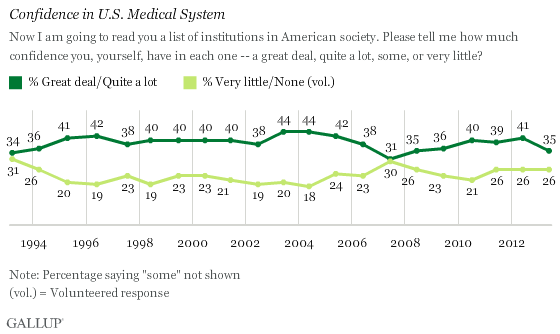PRINCETON, NJ -- Thirty-five percent of Americans have a great deal or quite a lot of confidence in the U.S. medical system, down from 41% last year, and the lowest since 2008. The current reading is also at the lower end of the range seen since Gallup first asked about the medical system in 1993.

Although Americans' confidence in the medical system is low on an absolute basis, it still ranks sixth on a list of 16 U.S. institutions Gallup measured in a June 1-4 survey, just below the presidency and just above the U.S. Supreme Court.
Confidence in the medical system had been higher over the past three years, but this year's 35% rating marks a return to where it was in 2008-2009. More broadly, confidence since 1993 has ranged between 31% in 2007 and 44% in 2003 and 2004, a fairly narrow spread around the historical average of 39%. Currently, 26% of Americans have very little or no confidence in the medical system, leaving 38% with "some" confidence.
This year marks the ramp-up to the full implementation of the Affordable Care Act next January, and the resulting attention the ACA has received could be a factor in Americans' lower levels of confidence in the U.S. medical system. Changes in partisan groups' confidence in the medical system -- particularly among Republicans, who tend to disapprove of the ACA -- support this possible explanation. Republicans' confidence fell by eight percentage points this year and is now, for the first time since 2004, below Democrats' confidence, albeit by one point. Republicans' confidence also fell between 2008 and 2009-2010, during the run-up to and passage of the ACA, suggesting that the renewed attention to the ACA could be a factor in the drop-off among Republicans. Democrats' confidence stayed within two points of where it was last year, while independents' confidence decreased by six points.

Implications
Americans' confidence in the U.S. medical system has dropped this year, after three years of improved confidence following the 2010 passage of the Affordable Care Act. Republicans' loss of confidence appears to be the biggest factor in this year's drop, perhaps resulting from the focus on the pending full implementation of the ACA in 2014. Although Americans' current level of confidence in the medical system is modest on an absolute basis, it is still higher than Americans' confidence in all but five of the 16 other U.S. institutions measured.
Survey Methods
Results for this Gallup poll are based on telephone interviews conducted June 1-4, 2013, with a random sample of 1,529 adults, aged 18 and older, living in all 50 U.S. states and the District of Columbia.
For results based on the total sample of national adults, one can say with 95% confidence that the margin of sampling error is ±3 percentage points.
Interviews are conducted with respondents on landline telephones and cellular phones, with interviews conducted in Spanish for respondents who are primarily Spanish-speaking. Each sample of national adults includes a minimum quota of 50% cellphone respondents and 50% landline respondents, with additional minimum quotas by region. Landline telephone numbers are chosen at random among listed telephone numbers. Cellphone numbers are selected using random digit dial methods. Landline respondents are chosen at random within each household on the basis of which member had the most recent birthday.
Samples are weighted to correct for unequal selection probability, nonresponse, and double coverage of landline and cell users in the two sampling frames. They are also weighted to match the national demographics of gender, age, race, Hispanic ethnicity, education, region, population density, and phone status (cellphone only/landline only/both, cellphone mostly, and having an unlisted landline number). Demographic weighting targets are based on the March 2012 Current Population Survey figures for the aged 18 and older U.S. population. Phone status targets are based on the July-December 2011 National Health Interview Survey. Population density targets are based on the 2010 census. All reported margins of sampling error include the computed design effects for weighting.
In addition to sampling error, question wording and practical difficulties in conducting surveys can introduce error or bias into the findings of public opinion polls.
For more details on Gallup's polling methodology, visit www.gallup.com.
